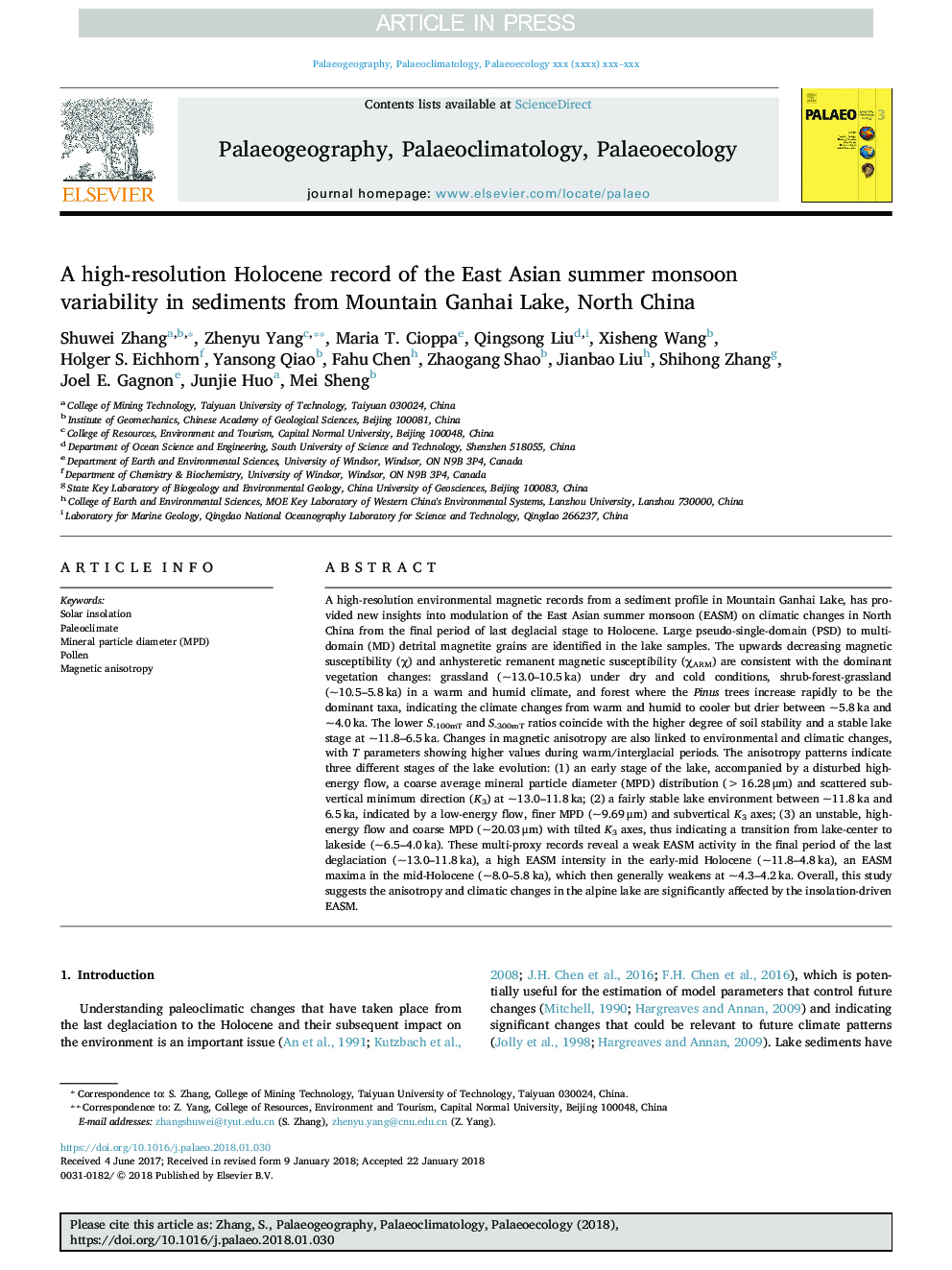| کد مقاله | کد نشریه | سال انتشار | مقاله انگلیسی | نسخه تمام متن |
|---|---|---|---|---|
| 8953048 | 1645895 | 2018 | 18 صفحه PDF | دانلود رایگان |
عنوان انگلیسی مقاله ISI
A high-resolution Holocene record of the East Asian summer monsoon variability in sediments from Mountain Ganhai Lake, North China
دانلود مقاله + سفارش ترجمه
دانلود مقاله ISI انگلیسی
رایگان برای ایرانیان
کلمات کلیدی
موضوعات مرتبط
مهندسی و علوم پایه
علوم زمین و سیارات
فرآیندهای سطح زمین
پیش نمایش صفحه اول مقاله

چکیده انگلیسی
A high-resolution environmental magnetic records from a sediment profile in Mountain Ganhai Lake, has provided new insights into modulation of the East Asian summer monsoon (EASM) on climatic changes in North China from the final period of last deglacial stage to Holocene. Large pseudo-single-domain (PSD) to multidomain (MD) detrital magnetite grains are identified in the lake samples. The upwards decreasing magnetic susceptibility (Ï) and anhysteretic remanent magnetic susceptibility (ÏARM) are consistent with the dominant vegetation changes: grassland (~13.0-10.5â¯ka) under dry and cold conditions, shrub-forest-grassland (~10.5-5.8â¯ka) in a warm and humid climate, and forest where the Pinus trees increase rapidly to be the dominant taxa, indicating the climate changes from warm and humid to cooler but drier between ~5.8â¯ka and ~4.0â¯ka. The lower S-100mT and S-300mT ratios coincide with the higher degree of soil stability and a stable lake stage at ~11.8-6.5â¯ka. Changes in magnetic anisotropy are also linked to environmental and climatic changes, with T parameters showing higher values during warm/interglacial periods. The anisotropy patterns indicate three different stages of the lake evolution: (1) an early stage of the lake, accompanied by a disturbed high-energy flow, a coarse average mineral particle diameter (MPD) distribution (>16.28â¯Î¼m) and scattered subvertical minimum direction (K3) at ~13.0-11.8â¯ka; (2) a fairly stable lake environment between ~11.8â¯ka and 6.5â¯ka, indicated by a low-energy flow, finer MPD (~9.69â¯Î¼m) and subvertical K3 axes; (3) an unstable, high-energy flow and coarse MPD (~20.03â¯Î¼m) with tilted K3 axes, thus indicating a transition from lake-center to lakeside (~6.5-4.0â¯ka). These multi-proxy records reveal a weak EASM activity in the final period of the last deglaciation (~13.0-11.8â¯ka), a high EASM intensity in the early-mid Holocene (~11.8-4.8â¯ka), an EASM maxima in the mid-Holocene (~8.0-5.8â¯ka), which then generally weakens at ~4.3-4.2â¯ka. Overall, this study suggests the anisotropy and climatic changes in the alpine lake are significantly affected by the insolation-driven EASM.
ناشر
Database: Elsevier - ScienceDirect (ساینس دایرکت)
Journal: Palaeogeography, Palaeoclimatology, Palaeoecology - Volume 508, 1 November 2018, Pages 17-34
Journal: Palaeogeography, Palaeoclimatology, Palaeoecology - Volume 508, 1 November 2018, Pages 17-34
نویسندگان
Shuwei Zhang, Zhenyu Yang, Maria T. Cioppa, Qingsong Liu, Xisheng Wang, Holger S. Eichhorn, Yansong Qiao, Fahu Chen, Zhaogang Shao, Jianbao Liu, Shihong Zhang, Joel E. Gagnon, Junjie Huo, Mei Sheng,